LG T1766NEFTU Owner’s Manual

OWNER'S MANUAL
WASHING
MACHINE
Before beginning installation, read these instructions carefully. This will simplify installation and ensure that the product is installed correctly and safely. Leave these instructions near the product after installation for future reference.
EN ENGLISH |
AR ةيبرعلا |
T1466NEFT* / 01 |
T1766NEFT* / 01 |
T1666NEFT* / 01 |
T1866NEFT* / 01 |
www.lg.com
Copyright © 2018 - 2019 LG Electronics Inc. All Rights Reserved.

TABLE OF CONTENTS
This manual may contain images or content different from the model you purchased.
This manual is subject to revision by the manufacturer.
SAFETY INSTRUCTIONS........................................................ |
4 |
IMPORTANT SAFETY INSTRUCTIONS.................................................... |
4 |
INSTALLATION....................................................................... |
10 |
Parts.......................................................................................................... |
10 |
Accessories............................................................................................... |
10 |
Specifications............................................................................................ |
11 |
Installation Place Requirements................................................................ |
12 |
Connecting the Supply Hose..................................................................... |
13 |
Installing the Drain Hose........................................................................... |
15 |
Leveling the Appliance.............................................................................. |
17 |
Assembling the Anti-Rat Cover (Optional)................................................ |
17 |
OPERATION............................................................................ |
18 |
Using the Appliance.................................................................................. |
18 |
Sorting Laundry......................................................................................... |
19 |
Adding Cleaning Products......................................................................... |
20 |
Control Panel............................................................................................ |
22 |
Washing Programme................................................................................. |
23 |
Option Programme.................................................................................... |
25 |
Manual Washing........................................................................................ |
27 |
Special Functions...................................................................................... |
28 |
SMART FUNCTIONS.............................................................. |
29 |
Using Smart Diagnosis™.......................................................................... |
29 |
MAINTENANCE...................................................................... |
30 |
Cleaning the Washing Machine................................................................. |
30 |
Cleaning the Water Inlet Filter................................................................... |
31 |
Cleaning the Lint Filter (Optional)............................................................. |
31 |
Caution on Freezing During Winter........................................................... |
33 |
TROUBLESHOOTING............................................................ |
34 |
Diagnosing Problems................................................................................ |
34 |
Error Messages......................................................................................... |
38 |
WARRANTY |
............................................................................40 |
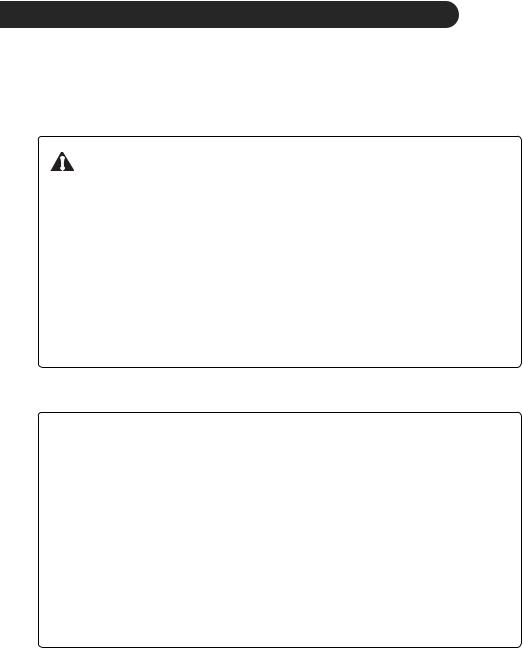
SAFETY INSTRUCTIONS
The following safety guidelines are intended to prevent unforeseen risks or damage from unsafe or incorrect operation of the appliance.
The guidelines are separated into ‘WARNING’ and ‘CAUTION’ as described below.
This symbol is displayed to indicate matters and
operations that can cause risk. Read the part with this symbol carefully and follow the instructions in order to avoid risk.
 WARNING
WARNING
This indicates that the failure to follow the instructions can cause serious injury or death.
 CAUTION
CAUTION
This indicates that the failure to follow the instructions can cause the minor injury or damage to the product.
IMPORTANT SAFETY INSTRUCTIONS
 WARNING
WARNING
To reduce the risk of explosion, fire, death, electric shock, injury or scalding to persons when using this product, follow basic precautions, including the following:
Children in the Household
This appliance is not intended for use by persons (including children) with reduced physical, sensory or mental capabilities, or lack of experience and knowledge, unless they have been given supervision or instruction concerning use of the appliance by a person responsible for their safety. Children should be supervised to ensure that they do not play with the appliance.
4

EN
Installation
••Never attempt to operate the appliance if it is damaged, malfunctioning, partially disassembled, or has missing or broken parts, including a damaged cord or plug.
••This appliance should only be transported by two or more people holding the appliance securely.
••Tighten the drain hose to avoid separation.
••If the power cord is damaged or the hole of the socket outlet is loose, do not use the power cord and contact an authorized service centre.
••Make sure the plug is completely pushed into the outlet.
••Do not install the appliance in a damp and dusty place. Do not install or store the appliance in any outdoor area, or any area that is subject to weathering conditions such as direct sunlight, wind, or rain or temperatures below freezing.
••Ventilation openings must not be obstructed by a carpet.
••Do not plug the appliance into multiple socket outlets or extension power cable.
••This appliance must be grounded. In the event of malfunction or breakdown, grounding will reduce the risk of electric shock by providing a path of least resistance for electric current.
••This appliance is equipped with a power cord having an equipment-grounding conductor and a grounding power plug. The power plug must be plugged into an appropriate socket outlet that is installed and grounded in accordance with all local codes and ordinances.
5

EN
••Improper connection of the equipment-grounding conductor can result in risk of electric shock. Check with a qualified electrician or service personnel if you are in doubt as to whether the appliance is properly grounded.
••Do not modify the power cord provided with the appliance.
Operation
••Do not use a sharp object like drill or pin to press or separate an operation unit.
••Keep the area underneath and around the appliance free of combustible materials such as lint, paper, rags, chemicals, etc.
••Do not put animals, such as pets into the appliance.
••Do not leave the appliance door open. Children may hang on the door or crawl inside the appliance, causing damage or injury.
••Use new hose or hose-set supplied with the appliance. Reusing old hoses can cause a water leak and subsequent property damage.
••Turn off water taps to relieve pressure on hoses and valves and to minimize leakage if a break or rupture should occur. Check the condition of the fill hoses; they may need replacement after 5 years.
••Never reach into the appliance while it is operating. Wait until the drum has completely stopped.
••Do not put in, wash or dry articles that have been cleaned in, washed in, soaked in, or spotted with combustible or explosive substances (such as waxes, wax removers, oil, paint, gasoline, degreasers, drycleaning solvents, kerosene, petrol, spot removers, turpentine, vegetable oil, cooking oil, acetone, alcohol, etc.). Improper use can cause fire or explosion.
6

EN
••In case of flood, disconnect the power plug and contact the LG Electronics customer information centre.
••Do not use or store flammable or combustible substances (ether, benzene, alcohol, chemical, LPG, combustible spray, insecticide, air freshener, cosmetics, etc.) near the appliance.
••If there is a gas leakage (isobutane, propane, natural gas, etc.), do not touch the appliance or power plug and ventilate the area immediately.
••If the drain hose or inlet hose is frozen during winter, use it only after thawing.
••Keep all washing detergents, softener and bleach away from children.
••Do not touch the power plug or the appliance controls with wet hands.
••Do not bend the power cable excessively or place a heavy object on it.
••Do not put your hand, foot or anything under the washing machine while the washing machine is in operation.
••The hands shall not be inserted into running water-extracting drum.
••Make sure that drainage is working properly. If water is not drained properly, your floor may get flooded.
••If, during spinning, opening the door does not stop the drum within about 15 seconds, immediately discontinue operating the appliance and contact your dealer or LG Electronics service centre.
7

EN
••Do not use a plug socket and wiring equipment for more than their rated capacity.
••When the air temperature is high and the water temperature is low, condensation may occur and thus wet the floor.
••Wipe off dirt or dust on the contacts of the power plug.
••Under certain conditions hydrogen gas may be produced in a water heater that has not been used for two weeks or more. Hydrogen gas can be explosive under these circumstances. If the HOT water has not been used for two weeks or more, prevent the possibility of damage or injury by turning on all Hot water taps and allowing them to run for several minutes. Do this before using any electrical appliance which is connected to the HOT water system. This simple procedure will allow any built-up hydrogen gas to escape. Since the gas is flammable, do not smoke or use an open flame or appliance during this process.
Maintenance
••Remove the power plug when you clean the appliance.
••Securely plug the power plug in the socket outlet after completely removing any moisture and dust.
••Do not spray water inside or outside the appliance to clean it.
••Never unplug the appliance by pulling on the power cable. Always grip the power plug firmly and pull straight out from the socket outlet.
••Only qualified service personnel from LG Electronics service centre should disassemble, repair, or modify the appliance. Contact an LG Electronics customer information centre if you move and install the appliance in a different location.
8
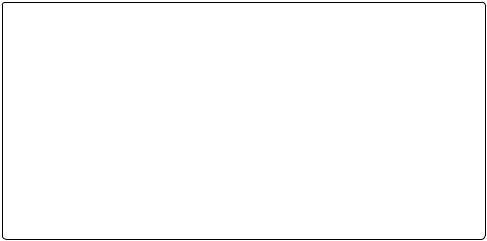
EN
Disposal
••Before discarding an old appliance, unplug it. Cut off the cable directly behind the appliance to prevent misuse.
••Dispose of all packaging materials (such as plastic bags and styrofoam) away from children. The packaging materials can cause suffocation.
••Remove the door before disposing of or discarding this appliance to avoid the danger of children or small animals getting trapped inside.
For One Valve Model
••Do not connect to hot water supply.
9
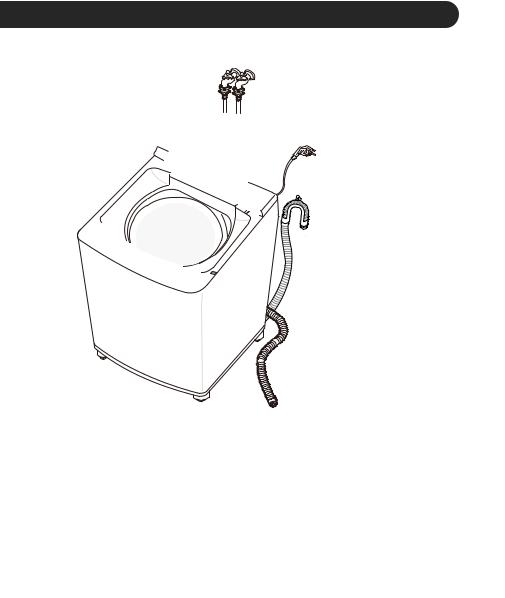
INSTALLATION
Parts
1 |
Door |
2 |
Tempered Glass |
3 |
Dispenser Drawer |
4 |
Softener Dispenser |
5 |
Bleach Dispenser |
6 |
Lint Filter |
7 |
Drum |
8 |
Leveling Feet |
9 |
Drain hose |
10 |
Water Supply Hose |
Accessories
|
|
|
Tie strap (Optional) |
|
|
|
|
||
|
|
|
||
or |
or |
or |
||
|
2 water supply hoses |
Drain hose |
Anti-rat cover |
Screw for Anti-rat cover |
(Hot + Cold) |
|
(Optional) |
(Optional) |
••Appearance and specifications may change without notice to improve the quality of the product.
10

|
|
|
EN |
Specifications |
|
|
|
|
|
|
|
Model |
T1466NEFT* / 01 |
T1666NEFT* / 01 |
T1866NEFT* / 01 |
|
|
|
|
Power Supply |
|
220 V~, 50 Hz |
|
Size |
632 mm (W) x 670 mm (D) x 1020 mm (H) |
||
Product Weight |
|
44.5 kg |
|
Allowable Water Pressure |
|
30 - 800 kPa |
|
Max. Capacity |
14 kg |
16 kg |
18 kg |
|
|
|
|
Model |
|
T1766NEFT* / 01 |
|
|
|
|
|
Power Supply |
|
220 - 240 V~, 50 Hz |
|
Size |
632 mm (W) x 670 mm (D) x 1020 mm (H) |
||
Product Weight |
|
44.5 kg |
|
Allowable Water Pressure |
|
30 - 800 kPa |
|
Max. Capacity |
|
17 kg |
|
••Appearance and specifications may change without notice to improve the quality of the product.
11
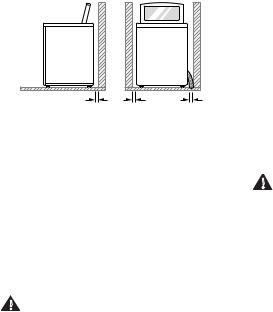
Installation Place
Requirements
Location
10 cm |
2 cm |
2 cm |
Level floor: Allowable slope under the entire appliance is 1°.
Power outlet: Must be within 1.5 meters of either side of the location of the appliance.
••Do not overload the outlet with more than one appliance.
Additional Clearance: For the wall, 10 cm: rear/2 cm: right & left side.
••Do not place or store laundry products on top of the appliance at any time. These products may damage the finish or controls.
WARNING
••The plug must be plugged into an appropriate outlet that is properly installed and grounded in accordance with all local codes and ordinances.
Positioning
••Install the appliance on a flat hard floor.
••Make sure that air circulation around the appliance is not impeded by carpets, rugs, etc.
••Never try to correct any unevenness in the floor with pieces of wood, cardboard or similar materials under the appliance.
EN
••If it is impossible to avoid positioning the appliance next to a gas cooker or coal burning stove, an insulation (85x60 cm) covered with aluminum foil on the side facing the cooker or stove must be inserted between the two appliances.
••Do not install the appliance in rooms where freezing temperatures may occur. Frozen hoses may burst under pressure. The reliability of the electronic control unit may be impaired at temperatures below freezing point.
••Ensure that when the appliance is installed, it is easily accessible for an engineer in the event of a breakdown.
••If the appliance is delivered in winter and temperatures are below freezing, place the appliance at room temperature for a few hours before putting it into operation.
WARNING
••This equipment is not designed for maritime use or for use in mobile installations such as caravans, aircraft etc.
Electrical Connection
••Do not use an extension cord or double adapter.
••Always unplug the appliance and turn off the water supply after use.
••Connect the appliance to an earthed socket in accordance with current wiring regulations.
••The appliance must be positioned so that the plug is easily accessible.
••Repairs to the appliance must only be carried out by qualified personnel. Repairs carried out by inexperienced persons may cause injury or serious malfunctioning. Contact your local service centre.
12

Connecting the Supply Hose
••Before connecting the water supply hose to the water tap, check the hose type and then choose the correct instruction.
••The water supply hose supplied may vary from country to country. Make sure to connect the blue supply hose to the COLD water tap, and the orange supply hose to the HOT water tap.
••Water supply pressure must be between 30 kPa and 800 kPa (0.3 - 8.0 kgf / cm²).
••Do not overtighten the water supply hose.
••If the water supply pressure is more than 800 kPa, a decompression device should be installed.
••Periodically check the condition of the hose and replace the hose if necessary.
Checking the Rubber Seal on the Supply Hose
Two rubber seals are supplied with the water supply hoses. They are used for preventing water leaks. Make sure the connection to taps is sufficiently tight.
Hose connector
Rubber seal 

Hose connector
Rubber seal

EN
Connecting Hose to Water Tap
Connecting Screw-Type Hose to Tap with Thread
Screw the hose connector onto the water supply tap.
Connecting Screw-Type Hose to Tap Without Thread
1 Loose the four fixing screws.
|
Upper |
Rubber |
|
connector |
seal |
|
Fixing screw |
|
2 |
Remove the guide plate if the tap is too |
|
|
large to fit the adapter. |
|
Guide plate
13
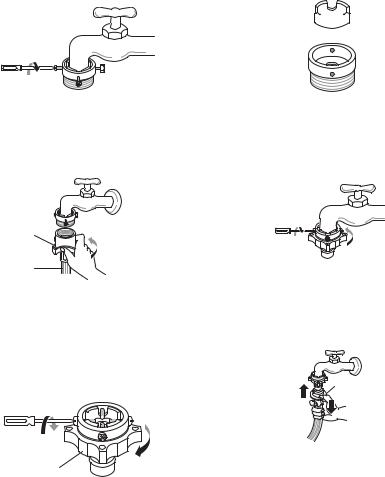
3 |
Push the adapter onto the end of the tap so |
|
that the rubber seal forms a watertight |
connection. Tighten the four fixing screws.
4 Push the supply hose vertically upwards so that the rubber seal within the hose can adhere completely to the tap and then tighten it by screwing it to the right.
Plate
Supply
hose
Connecting One Touch Type Hose to Tap Without Thread
1 |
Unscrew the adapter ring plate and loose |
||||||
|
the four fixing screws. |
||||||
|
|
|
|
|
|
|
|
|
|
|
|
|
|
|
|
Ring plate
EN
2 |
Remove the guide plate if the tap is too |
|
large to fit the adapter. |
Guide plate

3 Push the adapter onto the end of the tap so that the rubber seal forms a watertight connection. Tighten the four fixing screws and the adapter ring plate.
4 Pull the connector latch plate down, push the supply hose onto the adapter, and release the connector latch plate. Make sure the adapter locks into place.
Latch plate
NOTE
••After connecting the supply hose to the water tap, turn on the water tap to flush out foreign substances (dirt, sand, sawdust, and etc.) in the water lines. Let the water drain into a bucket, and check the water temperature.
14
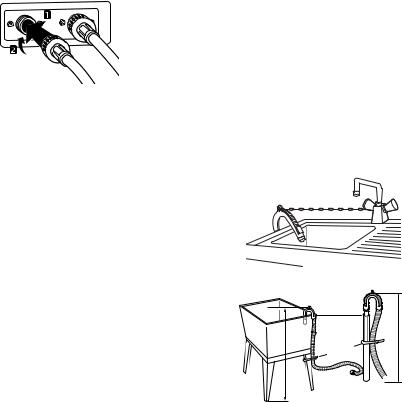
Connecting Hose to Appliance
Attach the hot water line to the hot water inlet on the back of the washing machine. Attach the cold water line to the cold water inlet on the back of the washing machine.
NOTE
••After completing connection, if water leaks from the hose, repeat the same steps. Use the most conventional type of tap for the water supply. In case the tap is square or too big, remove the guide plate before inserting the tap into the adaptor.
EN
Installing the Drain Hose
Before connecting the drain hose, check your drain hose model and choose the correct instruction.
Pump Model
••The drain hose should not be placed higher than 120 cm above the floor. Water in the washing machine may not drain or may drain slowly.
••Securing the drain hose correctly will protect the floor from damage due to water leakage.
••If the drain hose is too long, do not force it back into the washing machine. This will cause abnormal noise.
••When installing the drain hose to a sink, secure it tightly with string.
Laundry tub |
|
Hose |
|
retainer |
|
Tie strap |
<![if ! IE]> <![endif]>m 2.1 - 9.0 |
| <![if ! IE]> <![endif]>m 2.1 - 9.0 |
|
NOTE
••The discharge height should be approximately 0.9 - 1.2 m from the floor.
15
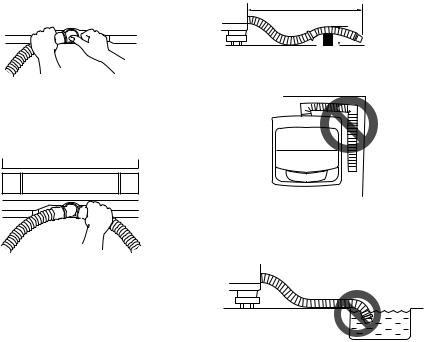
Non-pump Model
1 |
Push the elbow hose toward the body of the |
||||
|
washing machine. |
||||
|
|
|
|
|
|
|
|
|
|
|
|
|
|
|
|
|
|
|
|
|
|
|
|
|
|
|
|
|
|
2 |
To change the direction of the hose, pull out |
|
the elbow hose and change the direction. |
Repeat Step 1.
EN
Positioning the Drain Hose
••The length of the drain hose should not exceed 3 m.
••Do not place the drain hose on a threshhold of 6 cm or more.
max. 3 m

 max. 6 cm
max. 6 cm
••Make sure the drain hose is not kinked.
••The outlet of the drain hose should not be submerged in water.
••Make sure the drain hose is not kinked.
16
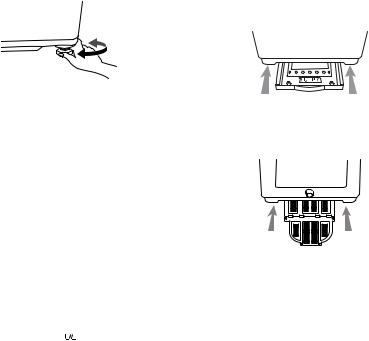
Leveling the Appliance
If the floor is uneven, turn the adjustable feet as required (Do not insert pieces of wood etc. under the feet). Make sure that all four feet are stable and resting on the floor and then check that the appliance is perfectly level.
Diagonal Check
••When pushing down the edges of the appliance top plate diagonally, the appliance should not move up and down at all (Check both directions). If the appliance rocks when pushing the machine top plate diagonally, adjust the feet again.
NOTE
••Timber or suspended type flooring may contribute to excessive vibration and unbalance.
••If the washing machine is installed on a raised platform, it must be securely fastened in order to eliminate the risk of falling off.
••If the washing machine is installed on a uneven, weak or tilted floor causing excessive vibration, spin failure or 

 error can occur. It must be placed on a firm and level floor to prevent spin failure.
error can occur. It must be placed on a firm and level floor to prevent spin failure.
EN
Assembling the Anti-Rat Cover (Optional)
Insert the Anti-Rat cover to the assembling hole from the front or back of the washing machine.
Type 1
Type 2
17

OPERATION
Using the Appliance |
4 |
||
Before the first wash, select a washing |
|
||
programme (Normal, add a half load of |
|
||
detergent), allow the washing machine to wash |
|
||
without clothing. This will remove residue and |
|
||
water from the drum that may have been left |
|
||
during manufacturing. |
|
||
1 Sort laundry and load items. |
|
||
••Sort laundry by fabric type, soil level, |
|
||
colour and load size as needed. Open the |
5 |
||
door and load items into the washing |
|||
machine. |
|
||
|
|
|
|
EN
Choose the desired wash programme.
••Press the Program button repeatedly until the desired programme is selected.
Begin programme.
••Press the Start/Pause button to begin the programme. The washing machine will agitate briefly without water to measure the weight of the load. If the Start/Pause button is not pressed within 60 minutes, the washing machine will shut off and all settings will be lost.
2 |
Add cleaning products and/or detergent and |
|
|
softener. |
|
|
••Add the proper amount of detergent to the |
|
|
detergent dispenser drawer. If desired, |
|
|
add bleach or fabric softener to the |
|
|
appropriate areas of the dispenser. |
|
3 |
Turn on the washing machine. |
|
|
••Press the Power button to turn on the |
|
|
washing machine. |
|
|
|
|
|
|
|
6 End of programme.
••When the programme is finished, a melody will sound. Immediately remove your clothing from the washing machine to reduce wrinkling.
NOTE
••The Auto Restart function allows the programme to restart by itself in case of power failure. lt resumes from the stage where it stopped.
18
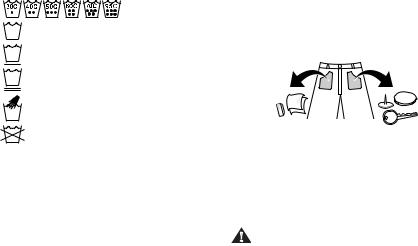
Sorting Laundry
1 Look for a care label on your clothes.
••This will tell you about the fabric content of your garment and how it should be washed.
••Symbols on the care labels.
[Wash temperature]
[Normal machine wash]
[Permanent press]
[Delicate]
[Hand wash]
[Do not wash]
2 Sorting laundry.
••To get the best results, sort clothes into loads that can be washed with the same wash cycle.
••Different fabrics need to be washed at varying temperatures and spin speeds.
••Wash two or more towels or knits together. If washed separately, laundry which absorbs a lot of water may not be washed well or abnormal spin-drying may occur due to leaning.
••Always sort dark colours from pale colours and whites. Wash separately as dye and lint transfer can occur causing discolouration of white and pale garments. If possible, do not wash heavily soiled items with lightly soiled ones.
−−Soil (Heavy, Normal, Light) :
Separate clothes according to amount of soil.
−−Colour (White, Lights, Darks): Separate white fabrics from coloured fabrics.
−−Lint (Lint producers, Collectors): Wash lint producers and lint collectors separately.
EN
3 Caring before loading.
••Combine large and small items in a load. Load large items first.
••Large items should not be more than half the total wash load. Do not wash single items. This may cause an unbalanced load. Add one or two similar items.
••Check all pockets to make sure that they are empty. Items such as nails, hair clips, matches, pens, coins and keys can damage both your washing machine and your clothes.
••Close zippers, hooks and strings to make sure that these items don’t snag on other clothes.
••Pre-treat dirt and stains by brushing a small amount of detergent dissolved water onto stains to help lift dirt.
CAUTION
••Do not wash or spin any item labeled or known to be water-proof or water-resistant, even if the product care label on the item permits machine washing. Failure to follow these instructions could result in severe damage to your laundry, your washing machine and/or property damage as a result of abnormal vibration of the washing machine.
−−Examples of water-proof or water-resistant items include certain mattress pads, mattress covers, rain gear, camping gear, skiing apparel, outdoor gear and similar items.
19
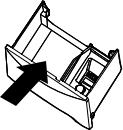
Adding Cleaning Products
Detergent Dosage
••Detergent should be used according to the instruction of the detergent manufacturer and selected according to type, colour, soiling of the fabric and washing temperature.
••If too much detergent is used, too many suds can occur and this will result in poor washing results or cause heavy load to the motor.
••If you wish to use liquid detergent follow the guidelines provided by the detergent manufacturer.
••You can pour liquid detergent directly into the main detergent drawer if you are starting the cycle immediately.
••Do not use liquid detergent if you are using Time delay, or if you have selected Pre Wash, as the liquid may harden.
••If too many suds occur, reduce the detergent amount.
••Detergent usage may need to be adjusted for water temperature, water hardness, size and soil level of the load. For best results, avoid oversudsing.
••Refer to the label of the clothes, before choosing the detergent and water temperature.
••When using the washing machine, use designated detergent for each type of clothing only:
−−General powdered detergents for all types of fabric
−−Powdered detergents for delicate fabric
−−Liquid detergents for all types of fabric or designated detergents only for wool
••For better washing performance and whitening, use detergent with the general powdered bleach.
••Detergent is flushed from the dispenser at the beginning of the cycle.
EN
••Dilute liquid detergent with water and pour into the drum, start the cycle.
••Using liquid detergent without diluting, or leaving laundry for a long time after pouring diluted liquid detergent into the drum might cause damage, bleaching or discoloration of cloth.
NOTE
••Do not let the detergent harden. Doing so may lead to blockages, poor rinse performance or odour.
••Full load : According to manufacturer’s recommendation.
••Part load : 3/4 of the normal amount
••Minimum load : 1/2 of full load
Adding Detergent
••Follow the detergent package directions. Using too little detergent is a common cause of laundry problems. Use more detergent if you have hard water, large loads, greasy or oily soils or lower water temperature.
••Soap flakes or granulated soap powders should not be used in your washing machine. When washing woolens, remember to use detergent suitable for washing woolens.
NOTE
••Too much detergent, bleach or softener may cause an overflow.
20
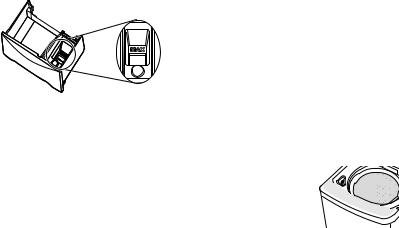
Adding Fabric Softener
••Dilute fabric softener with water. Undiluted fabric softener may result in spots that look like oil stain.
••Measure and add the recommended amount of fabric softener into the compartment marked with this symbol (  ).
).
−−Follow manufacturer’s direction.
−−Fabric softener is automatically dispensed in the final rinse with indication beep.
−−If you want extra rinse, you must add fabric softener manually when indication beep rings in the final rinse. This maximizes the fabric softener function.
••Do not overfill. The dispenser holds max 35 mL. Never add more than 35 mL. Overfilling can cause early dispensing of the fabric softener which could result in stained clothes. A cup with a pouring spout will help you avoid spelling.
••The effect of adding fabric softener may vary according to its viscosity. The sticker fabric softener makes its effect lower. For a sticky softener it is recommended that it be diluted with water, then be manually put during the time when the washer beeps several times before the final rinse. This function informing correct time dispense manually is optionally applied to some models. Please keep it in mind that fabric softener has to be diluted with water before dispensed and poured directly on clothes.
EN
NOTE
••Do not mix with detergent or bleach.
••Never pour fabric softener directly on clothes.
It may stain them.
••Do not stop the washer during the first spin for timely dispensing.
••Option washing is not designed to be used with fabric softener dispenser.
Adding Liquid Bleach
••Check clothing care label for special instructions and separate the laundry to be bleached.
••Dilute liquid chlorine bleach.
••Measure the recommended amount of liquid bleach carefully following instructions on the bottle.
••Before starting the washing machine, pour the measured amount of bleach directly into the bleach dispenser. Avoid splashing or overfilling. Powdered bleach should be mixed with water before being poured into the dispenser.
NOTE
••Never pour undiluted liquid bleach directly onto clothes or into the wash basket. This may cause change of color or damage the laundry.
••Do not pour powdered bleach into the bleach dispenser.
21
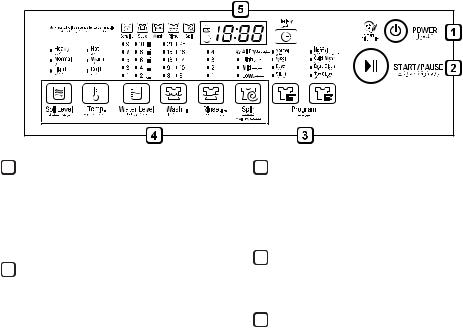
EN
Control Panel
1Power Button
••Press the Power button to turn the washing machine on.
••The appliance will automatically turn off once a certain time has passed after the wash has completed.
2Start/Pause Button
••Press the Start/Pause button to start the wash cycle or pause the wash cycle.
••If a temporary stop of the wash cycle is needed, press the Start/Pause button.
3Program Button
••Programmes are available according to laundry type.
••Lamp will light up to indicate the selected programme.
4Option Button
••Press buttons to select the desired options.
5Display
••The display shows the settings, estimated time remaining, options, and status messages. When the product is turned on, the default settings in the display will illuminate.
••The process lamp will remain prior to it beginning. The process lamp will blink during that process, and the lamp will then turn off when that process has completed.
22

Washing Programme
Wash cycles are designed for the best wash performance for each type of load. Select the programme that best matches the load contents for maximum wash performance and fabric care. Press the Program button to select the desired programme. When you select a wash programme, the light for the corresponding wash programme will turn on.
Normal
Use this programme to wash normal loads. The built-in sensor detects the size of the load, calculating wash, rinse and, spin settings accordingly.
••If water or wet laundry is already in the drum before starting, the water level will be increased.
••For lightweight bulky loads, the water level may be too low and should be increased manually.
Wool
Use this programme to wash delicate fabrics such as lingerie and woolens. Before washing, check the care label for the washing instructions.
••This programme uses a slow spin to extract water from laundry, so the laundry has more moisture than normal.
••Only cold water will be used for this programme as hot water may damage laundry.
NOTE
••Hang or lay flat to dry your delicates.
EN
Duvet
Use this programme to wash a blanket or bedclothes with hand wash sign.
••Cashmere bedclothes, acrylic blanket, mixed spinning blanket, woolen blanket, infilling (polyester 101), and bed sheet might be damaged by floating. Please purchase a separate laundry net to wash.
••Separate bed clothes from general clothes. It might cause laundry to askew and results in abnormal washing.
••Spin dry might take longer to spread out laundry if bedclothes are lumped to a side.
••Never wash an electric blanket and a carpet. It cause damage to a laundry machine and the laundry.
••Please use a laundry net to soak and sink bedclothes that are easily inflated. It might cause damage to laundry and machine parts if inflated.
••Regardless of its size, we recommend to wash one by one. If two bedclothes with different materials are washed at a time, it might cause abnormal spin dry due to imbalance.
NOTE
••How to put a blanket into the drum
Below this line
23
Silent
Use this programme to wash quietly in silent especially during late night and dawn.
••This programme takes longer washing time than the Normal programme.
••To reduce noise in spinning, this programme uses a slow spin to extract water from laundry, so the laundry has more moisture than normal.
Pre Wash + Normal
Use this programme to pretreat immediate stain without handwash. It is necessary for clothes which could smell bad without prompt laundry.
EN
Quick Wash
Use this programme to wash lightly soiled clothes for a short time. This programme's recommended laundry amount is under 3 kg.
Extra Clean
Use this programme to increase rinsing performance. This would include underwear and baby clothes. If someone has sensitive skin or skin trouble, use this programme.
24
